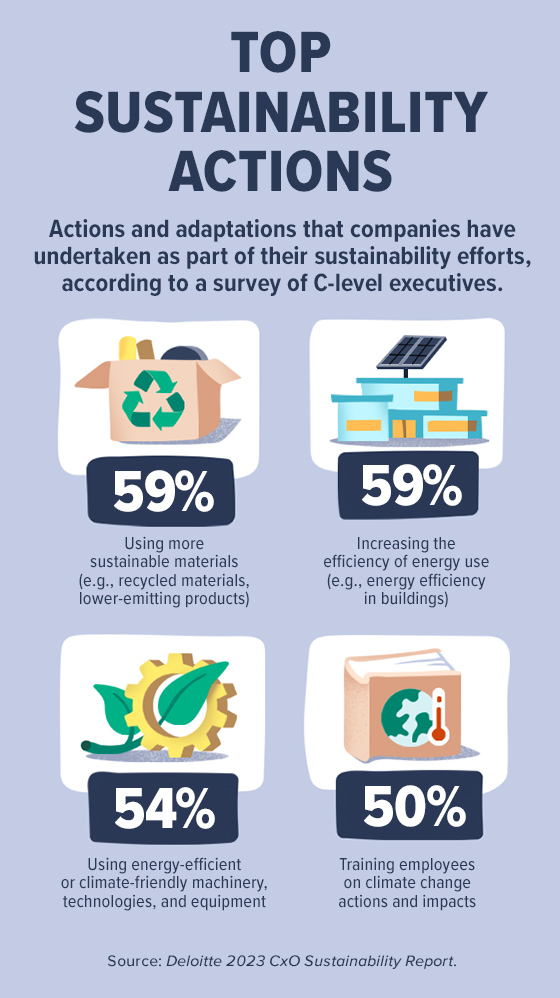Working Toward Sustainable Success
Companies that can’t get sustainability right lose the trust of their employees

Climate change isn’t just a danger to the environment, it’s a risk to companies that can’t get their response right.
Companies now face crosswinds that include new U.S. Securities and Exchange Commission (SEC) rules, politicized views of the issue, and demands from investors, the public, suppliers and employees—especially younger employees.
“Getting it right in terms of sustainability is critical. It is also not easy,” says Kelley Vendeland, vice president of marketing and sustainability at energy efficiency technology manufacturer Energy Recovery Inc., headquartered in San Leandro, Calif. One key is to make sure you’re in regular discussions with stakeholders to understand their priorities, Vendeland says. Then, look at how those priorities “interact with what management believes is important from a sustainability perspective to meet business goals,” she says.
Pairing stakeholder priorities with business goals that are challenging but achievable is key, instead of throwing out “pie in the sky” promises that will erode trust, Vendeland says.
“If you get it wrong, the biggest risk is you lose trust … with employees,” she says—the very people who generate some of the most innovative ideas on sustainability.
Commitment to the Climate
In March, the SEC approved new rules on what companies must disclose about their own emissions and the climate risks they face. The SEC backed away from a previous proposal to require companies to disclose all emissions in their “value chain”—including how their products are disposed of and the pollution created by suppliers. California already requires that information about the carbon footprint of a company’s supply chain, as does the European Union.
It’s just really good business to have a sustainable business.”
Cheryl D’Cruz-Young
In some ways, the public and investors are ahead of the SEC on the issue. In response to pressure, many companies in recent years began voluntarily disclosing how much greenhouse gas they emit. Some are pledging to work faster than the United Nations policy goal for nations to achieve net zero emissions by 2050. And some have made bold moves—like General Motors’ recent announcement that it will switch to selling only electric vehicles by 2035.
Over the past three years, investors have stepped up their pressure for climate action, says Cheryl D’Cruz-Young, senior client partner for sustainability and ESG (environmental, social and governance) at the management and consulting firm Korn Ferry. “It’s just really good business to have a sustainable business,” D’Cruz-Young says.
“You’ve got a planet that’s burning before your eyes,” she says. “We need collective brain power.”
Her firm helps companies search for chief sustainability officers and interim executives with expertise in the technology of carbon capture usage and storage. Those experts can help existing companies that are starting new ventures or aid startups scaling up.
Crosswinds
A Deloitte global survey of C-suite officers identified climate change as a top issue, right behind the economic outlook and ahead of innovation, talent competition and supply chain challenges. Three-quarters of executives said their organization stepped up its sustainability investments in the previous year.
But Deloitte notes those efforts are unlikely to result in meaningful transformations without executive buy-in. About 21 percent of those surveyed said their organization has no plans to tie compensation for senior leaders to sustainability performance.
And some organizations are backing off climate action amid the nation’s political polarization and fears in some quarters of an economic slowdown. A survey by U.S. Bank of senior financial professionals showed that fewer companies were focusing on ESG reporting as they prioritized cost-cutting efforts. Last year, 31 percent worked on ESG reporting, compared with 41 percent two years earlier in 2021.
Measuring the success of sustainability efforts is no easy task. After decades of focusing on building shareholder value, companies in recent years started looking at not just their profit but also their impact on society and the environment (known as the triple bottom line). The Global Reporting Initiative, a nonprofit that promotes economic sustainability, gave some form to the idea of reporting on sustainability by providing a common language for corporations to report those impacts.
Vendeland says the “alphabet soup” caused by rating agencies using different sustainability metrics is challenging for corporations. She’d like to see a standardized system for measuring sustainability progress, like the Generally Accepted Accounting Principles used to ensure the accuracy of financial records.
What Are Businesses Doing Today?
Sustainability efforts can cover a wide range of activities designed to reduce emissions and care for the planet.
The top approaches organizations are adopting, as noted in the Deloitte report, are the use of sustainable materials, energy efficiency measures, and climate-friendly machinery and technology. Companies are also developing climate-friendly products and requiring suppliers to meet sustainability criteria.
At Manulife Financial Corporation, based in Toronto, company leaders involved employees in sustainability efforts last year. They planted 631 trees, collected 62 kilograms of trash at events and helped educate the public on how to be more environmentally sensitive.
And at Energy Recovery, each executive is assigned responsibility for a sustainability goal so that workload is spread throughout the organization. The “owner” of each goal is responsible for reporting their progress at regular management meetings. Goals include holding sustainability trainings, reducing emissions and making safe products.
Vendeland says the company is looking at the climate risks it faces and its own environmental footprint. She says her company has been successful in the eyes of the rating agencies. One key is setting goals that have a road map to success, she says: “If it feels too fluffy, that’s where the skepticism comes in.”
Influence from Employees
It’s not just outside influences pushing companies toward climate action, but also employees.
Sarah Chapman, global chief sustainability officer at Manulife, remembers when corporate focus on environmental issues was the purview of a pocket of staff. No longer.
“It’s being decentralized,” Chapman says. That means that finance departments are thinking about how to account for emissions, risk management is worrying about environment and societal dangers, procurement is looking at the whole value chain, and the operations team is considering sustainability in real estate decisions. That, in turn, will help companies meet the environmental promises they make.
“When this gets embedded in people’s roles, it becomes more ingrained in the business operations and business strategy,” Chapman says.
That is driven by enthusiasm from job applicants who want to know not just what the company is doing on sustainability but how they can incorporate actions into their jobs, Chapman says. She thought that the drive would plateau, but potential hires still ask sustainability questions during interviews. And applicants, along with rating agencies and investors, are the top downloaders of the company’s ESG reports.
What matters from a retention perspective is that people feel that they can embed a sense of purpose and sustainability into their jobs.”
Sarah Chapman
The improved data on companies’ sustainability efforts is making it easier for prospective employees to judge employers. “It is enabling the workforce to determine where they want to … put their brainpower, where do they see value in contributing,” D’Cruz-Young says.
The interest is global, she says, including for Asian applicants from places such as the Philippines and Malaysia, which are coastal countries that are threatened by global warming. “They are seeing the effects of climate change in a physical, in-your-face way,” Chapman says.
Manulife gives workers one day off per year to volunteer for environmental and other causes and matches employees’ donations to charitable organizations.
The company’s efforts on sustainability help with recruitment, retention and engagement. Employees “want to believe in the purpose of an organization,” Chapman says. “What matters from a retention perspective is that people feel that they can embed a sense of purpose and sustainability into their jobs.”
Deloitte’s 2023 Gen Z and Millennial Survey bears out Chapman’s experience. More than half of those surveyed in each generational group said they research a company’s environmental impact before accepting a job. And nearly a quarter said they plan to change jobs or sectors in the future because of climate concerns. About half said they are pressuring companies to take action.
Vendeland says Energy Recovery is committed to listening to employee feedback. An intern noticed that some products still came with paper manuals and calculated the waste, water and emissions involved in printing those. The company quickly ditched the paper manuals and now offers QR codes and digital manuals instead.
“The employee stakeholder group is the one I believe holds us to the highest standard,” Vendeland says. “Ignoring the ideas that come from that group, you do at your own peril.”
D’Cruz-Young points out that Millennial workers are now reaching middle management and have influence within their companies. And older workers like Baby Boomers and members of Generation X may be looking ahead to their legacy and wanting to make a difference. D’Cruz-Young, a member of Generation X, says she is charged up every time she thinks of her teenage son’s plea that when it comes to achieving net zero emissions, 2050 is too late.
Tamara Lytle is a freelance writer in the Washington, D.C., area.
 |
The federal Inflation Reduction Act, which became law in 2022, is full of incentives to reduce greenhouse gas emissions. The law offers numerous subsidies to businesses, households and local governments for clean energy investments. The idea is to move the U.S. away from fossil fuels that contribute to climate risk. The Economic Policy Institute estimated last summer that the law spurred a 54 percent hike in investments in building or expanding factories in the previous year. According to the White House, the measure created 170,000 clean energy jobs in its first year and spurred $110 million in new manufacturing investments. Cheryl D’Cruz-Young at Korn Ferry calls it a “game-changer” for companies and says it has drawn business to the U.S. “We’ve got a lot of inbound investment of organizations who are delivering decarbonization solutions” because of the incentives in the law, she says. –T.L. |
